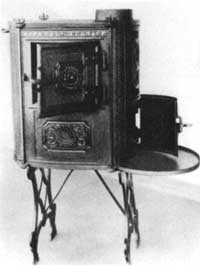|
HOPEWELL VILLAGE National Historic Site |
 |
Hopewell in the Early Nineteenth Century
It was under the Brookes that Hopewell reached its greatest prosperity. In 1800 and the years following, extensive repairs were made to the furnace and structures and improvements added to operating equipment both at the furnace and the mine holes. A stamping mill was constructed in 1805 to salvage iron from the slag, formerly a total loss, and in 1817 a cupola, or resmelting furnace, was added to increase the output of small castings. By the 1820's the furnace was operating at its peak, generally in excess of 300 days out of the year as compared with 235 days or less in former years. In the blast of 1800 Hopewell produced only 252 tons of pig iron and 59 tons of finished castings, while in the blast of 1824 the tonnage was 533 and 324, respectively. In those far-off days this was considered excellent, especially for an essentially eighteenth-century furnace.
 A ten-plate (flask cast) stove made at Hopewell during the early part of the nineteenth century. Progress in the technique of stove-casting was rapid following the Revolutionary War. |
While blast furnaces were designed primarily to produce pig iron for nearby forges, the growing need for finished castings for household, agricultural, and industrial uses made it profitable to concentrate more and more on the latter. This was particularly true during the "Canal Era" when distant markets could be reached cheaply by boat. With the completion of the Schuylkill and Union Canals, Hopewell found a ready marker for all the finished castings it could produce, in Philadelphia, New York, Wilmington, Baltimore, and even more distant points. Thus, during the 15-year period from 1825 to 1840, more finished castings than pig iron were made here.
A large portion of these castings supplied the Philadelphia market most of it in the form of stoves and fireplaces. In 1830, for instance, 777 stoves were purchased by 11 firms of that city. Hopewell produced a large assortment of cooking and heating stoves—at one time as many as 23 types and sizes. They were of fine quality, as surviving examples testify. There were "circular," "square," "stone coal," and "cannon" stoves. Most of them bore the name, "Hopewell," or that of the furnace owners, "Brooke and Buckley"; others were labeled: "Heiss," "Win Penn," "Perry's Victory," "Wilmington," and so on.
But stoves were by no means the only castings made. Pots, pans, kettles, bake plates, mortars, and waffle irons for the household; mold boards, "corn-shelling machines," and windmill irons for the farmer; and "machinery castings" for industrial use were among the important products of the furnace in this era. Even unusual orders were sometimes filled. Thus, in 1817, a special "steam" stove was made for Dr. Joseph Shippen of Philadelphia. While in 1825—26, Hopewell supplied much of the cast-iron installations used in the cell blocks of historic Eastern State Penitentiary at Philadelphia. This penitentiary, begun in 1823 and completed in 1829, was revolutionary in design and for many years considered the finest in the world.
The visitor gazing upon the silent remains of the furnace group today can hardly realize that this quiet spot once surged with great activity; that in 1824, for instance, not less than 2,995 stoves were cast, in addition to other castings and pig iron; and that in the busy 1830's well over 160 men and boys were actively employed.
The climax in Hopewell's industrial career came in 1836, following extensive improvements and repairs in the preceding years and the rebuilding of the furnace in 1828. In the blast of that year, the furnace was in operation for 445 days, from January 3, 1836, to April 10, 1837, the longest in the entire history of Hopewell. A total of 1,169 tons of mixed castings was produced, exceeded only by the blast of 1853, with its record 1,205 tons of pig iron. Considering that more than half or 720 tons, of the 1836 figure represented finished castings, which is a time-consuming process, that year's record is actually more impressive than the one for 1853. The daily average of 2.6 tons, also, was the highest for any year between 1770 and 1845, the period during which mixed castings were produced. Hopewell products were so much in demand in 1836 that the furnace was often forced to turn down orders from new customers, as scores of business letters of this period reveal.

|
|
Last Modified: Mon, Dec 2 2002 10:00:00 am PDT |


